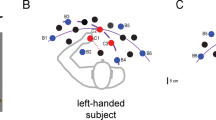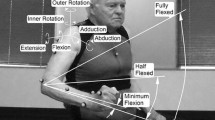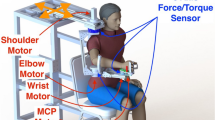Abstract
It has been suggested that multijoint movements result from the specification of a referent configuration of the body. The activity of muscles and forces required for movements emerge depending on the difference between the actual and referent body configurations. We identified the referent arm configurations specified by the nervous system to bring the arm to the target position both in healthy individuals and in those with arm motor paresis due to stroke. From an initial position of the right arm, subjects matched a force equivalent to 30% of their maximal voluntary force in that position. The external force, produced at the handle of a double-joint manipulandum by two torque motors, pulled the hand to the left (165°) or pushed it to the right (0°). For both the initial conditions, three directions of the final force (0°, +20°, and −20°) with respect to the direction of the initial force were used. Subjects were instructed not to intervene when the load was unexpectedly partially or completely removed. Both groups of subjects produced similar responses to unloading of the double-joint arm system. Partial removal of the load resulted in distinct final hand positions associated with unique shoulder-elbow configurations and joint torques. The net static torque at each joint before and after unloading was represented as a function of the two joint angles describing a planar surface or invariant characteristic in 3D torque/angle coordinates. For each initial condition, the referent arm configuration was identified as the combination of elbow and shoulder angles at which the net torques at the two joints were zero. These configurations were different for different initial conditions. The identification of the referent configuration was possible for all healthy participants and for most individuals with hemiparesis suggesting that they preserved the ability to adapt their central commands—the referent arm configurations—to accommodate changes in external load conditions. Despite the preservation of the basic response patterns, individuals with stroke damage had a more restricted range of hand trajectories following unloading, an increased instability around the final endpoint position, altered patterns of elbow and shoulder muscle coactivation, and differences in the dispersion of referent configurations in elbow-shoulder joint space compared to healthy individuals. Moreover, 4 out of 12 individuals with hemiparesis were unable to specify referent configurations of the arm in a consistent way. It is suggested that problems in the specification of the referent configuration may be responsible for the inability of some individuals with stroke to produce coordinated multijoint movements. The present work adds three findings to the motor control literature concerning stroke: non-significant torque/angle relationships in some subjects, narrower range of referent arm configurations, and instability about the final position. This is the first demonstration of the feasibility of the concept of the referent configuration for the double-joint muscle-reflex system and the ability of some individuals with stroke to produce task-specific adjustments of this configuration.










Similar content being viewed by others
References
Archambault PS, Mihaltchev P, Levin MF, Feldman AG (2001) Parametric control of the arm analysed by unloading using a double-joint manipulandum. 31st Annual Meeting Soc Neurosci Abstracts 941.11, San Diego, CA
Asatryan DG, Feldman AG (1965) Functional tuning of the nervous system with control of movements or maintenance of a steady posture. I. Mechanographic analysis of the work of the joint on execution of a postural tasks Biophysics 10:925–935
Beer RF, Dewald JPA, Rymer WZ (2000) Deficits in the coordination of multijoint arm movements in patients with hemiparesis: evidence for disturbed control of limb dynamics. Exp Brain Res 131:305–319
Bohannon RW, Larkin PA, Smith MB, Horton MG (1987) Relationship between static muscle strength deficits and spasticity in stroke patients with hemiparesis. Phys Ther 67:1068–1071
Bourbonnais D, Vanden Noven S (1989) Weakness in patients with hemiparesis. Am J Occup Ther 43:313–317
Brunnström S (1970) Movement therapy in hemiplegia. A neurophysiological approach. Harper and Row, New York
Burke D (1988) Spasticity as an adaptation to pyramidal tract injury. Adv Neurol 7:401–423
Chen R, Cohen LG, Hallett M (1997) Role of the ipsilateral motor cortex in voluntary movement. Can J Neurol Sci 24:284–291
Cirstea MC, Levin MF (2000) Compensatory strategies for reaching in stroke. Brain 123:940–953
Cirstea MC, Mitnitski AB, Feldman AG, Levin MF (2003) Interjoint coordination dynamics during reaching in stroke. Exp Brain Res 151:289–300
Colebatch JG, Gandevia SC, Spira PJ (1986) Voluntary muscle strength in hemiparesis: distribution of weakness at the elbow. J Neurol Neurosurg Psychiatry 49:1019–1024
Conrad B, Benecke R, Meinck HM (1985) Gait disturbances in paraspastic patients. In: Delwaide PJ, Young RR (eds) Restorative neurology. Clinical neurophysiology in spasticity, vol 1. Elsevier, Amsterdam, pp 155–174
Coté JN, Mathieu PA, Levin MF, Feldman AG (2002) Movement reorganization to compensate for fatigue during sawing. Exp Brain Res 146:394–398
Crago PE, Houk JC, Hasan Z (1976) Regulatory action of human stretch reflex. J Neurophysiol 39:925–935
Dewald JP, Pope PS, Given JD, Buchanan TS, Rymer WZ (1995) Abnormal muscle coactivation patterns during isometric torque generation at the elbow and shoulder in hemiparetic subjects. Brain 118:495–510
Dickstein R, Hocherman S, Amdor G, Pillar T (1993) Reaction and movement times in patients with hemiparesis for unilateral and bilateral elbow flexion. Phys Ther 73:374–385
Feldman AG (1966) Functional tuning of the nervous system with control of movement or maintenance of a steady posture. II. Controllable parameters of the muscle. Biophysics 11:565–578
Feldman AG (1979) Central and reflex mechanisms in the control of movement. Nauka, Moscow
Feldman AG, Levin MF (1995) The origin and use of positional frames of reference in motor control. Behav Brain Sci 18:723–744
Feldman AG, Orlovsky GN (1972) The influence of different descending systems on the tonic stretch reflex in the cat. Exp Neurol 37:481–494
Feldman AG, Levin MF, Mitnitski A, Archambault P (1998) Multi-muscle control in human movements. Keynote lecture. J Electromyogr Kinesiol 8:383–390
Forget R, Lamarre Y (1987) Rapid elbow flexion in the absence of proprioceptive and cutaneous feedback. Hum Neurobiol 6:27–37
Franklin DW, Milner TE (2003) Adaptive control of stiffness to stabilise hand position with large loads. Exp Brain Res 152:211–220
Fugl-Meyer AR, Jääskö L, Leyman I, Olsson S, Steglind S (1975) The post-stroke hemiplegic patient. 1. A method for evaluation of physical performance. Scand J Rehabil Med 7:13–31
Gomi H, Osu R (1998) Task-dependent viscoelasticity of human multijoint arm and its spatial characteristics for interaction with environments. J Neurosci 18:8965–8978
Goulet C, Arsenault AB, Bourbonnais D, Laramee MT, Lepage Y (1996) Effects of transcutaneous electrical nerve stimulation on H-reflex and spinal spasticity. Scand J Rehabil Med 28:169–176
Gowland C, deBruin H, Basmajian JV, Plews N, Burcea I (1992) Agonist and antagonist activity during voluntary upper-limb movement in patients with stroke. Phys Ther 72:624–633
Hammond MC, Fitts SS, Kraft GH, Nutter PB, Trotter MJ, Robinson LM (1988) Co-contraction in the hemiparetic forearm: quantitative EMG evaluation. Arch Phys Med Rehabil 69:348–351
Hogan N (1985) The mechanics of multi-joint posture and movement control. Biol Cybern 52:315–331
Hufschmidt A, Mauritz K-H (1985) Chronic transformation of muscle in spasticity: a peripheral contribution to increased tone. J Neurol Neurosurg Psychiatry 48:676–685
Jakobsson F, Grimby L, Edstrom L (1992) Motoneuron activity and muscle fibre type composition in hemiparesis. Scand J Rehabil Med 24:115–119
Kamper DG, McKenna-Cole AN, Kahn LE, Reinkensmeyer DJ (2002) Alterations in reaching after stroke and their relation to movement direction and impairment severity. Arch Phys Med Rehabil 83:702–707
Knutsson E, Richards C (1979) Different types of disturbed motor control in gait of hemiparetic patients. Brain 102:405–430
Lestienne FG, Thullier F, Archambault P, Levin MF, Feldman AG (2000) Multi-muscle control of head movements in monkeys: the referent configuration hypothesis. Neurosci Lett 283:65–68
Levin MF (1996) Interjoint coordination during pointing movements is disrupted in spastic hemiparesis. Brain 119:281–293
Levin MF, Dimov M (1997) Spatial zones for muscle coactivation and the control of postural stability. Brain Res 757:43–59
Levin MF, Feldman AG (1994) The role of stretch reflex threshold regulation in normal and impaired motor control. Brain Res 657:23–30
Levin MF, Hui-Chan CW (1992) Relief of hemiparetic spasticity by TENS is associated with improvement in reflex and voluntary motor functions. Electroencephalogr Clin Neurophysiol 85:131–142
Levin MF, Lamarre Y, Feldman AG (1995) Control variables and proprioceptive feedback in fast single-joint movement. Can J Physiol Pharmacol 73:316–330
Levin MF, Selles RW, Verheul MH, Meijer OG (2000) Deficits in the coordination of agonist and antagonist muscles in stroke patients: implications for normal motor control. Brain Res 853:352–369
Levin MF, Cirstea CM, Archambault P, Son F, Roby-Brami A (2002) Impairment and compensation of reaching in patients with stroke and cerebral palsy. In: Latash ML (ed) Progress in motor control, vol 2. Structure-function relations in voluntary movements. Human Kinetics, Champaign, IL, pp 103–122
Matthews PBC (1959) A study of certain factors influencing the stretch reflex of the decerebrate cat. J Physiol 147:547–564
McIntyre J, Mussa-Ivaldi FA, Bizzi E (1996) The control of stable postures in multijoint arm. Exp Brain Res 110:248–264
Michaelsen SM, Luta A, Roby-Brami A, Levin MF (2001) Effect of trunk restraint on the recovery of reaching movements in hemiparetic patients. Stroke 32:1875–1883
Mihaltchev P, Archambault PS, Feldman AG, Levin MF (2002) Referent configuration of the arm in patients with stroke. Program no. 169.6, Abstract Viewer/Itinerary Planner, Washington DC, Soc for Neurosci, CD-ROM
Milner TE (2002) Adaptation to destabilising dynamics by means of muscle cocontraction. Exp Brain Res 143:406–416
Nadeau S, Arsenault AB, Gravel D, Bourbonnais D (1999) Analysis of the clinical factors determining natural and maximal gait speeds in adults with a stroke. Am J Phys Med Rehabil 78:123–130
Newell KM, Houk JC (1983) Speed and accuracy of compensatory responses to limb disturbance. J Exp Psychol 9:58–74
Ostry DJ, Gribble PL, Levin MF, Feldman AG (1997) Phasic and tonic stretch reflexes in muscles with few muscle spindles: human jaw-opener muscles. Exp Brain Res 116:299–308
Reinkensmeyer DJ, McKenna Cole A, Kahn LE, Kamper DG (2002) Directional control of reaching is preserved following mild/moderate stroke and stochastically constrained following severe stroke. Exp Brain Res 143:525–530
Roby-Brami A, Fuchs S, Mokhtari M, Bussel B (1997) Reaching and grasping strategies in hemiparetic patients. Motor Control 1:72–91
St-Onge N, Feldman AG (2004) Referent configuration of the body: a global factor in the control of multiple skeletal muscles. Exp Brain Res 155:291–300
Tang A, Rymer WZ (1981) Abnormal force-EMG relations in paretic limbs of hemiparetic human subjects. J Neurol Neurosurg Psychiatry 44:690–698
Trombly CA (1993) Observations of improvement of reaching in five subjects with left hemiparesis. J Neurol Neurosurg Psychiatry 56:40–45
Twitchell TE (1951) The restoration of motor function following hemiplegia in man. Brain 74:443–480
Weijs WA, Sugimura T, van Ruijven LJ (1999) Motor coordination in a multi-muscle system as revealed by principal components analysis of electromyographic variation. Exp Brain Res 127:233–243
Wiesendanger M (1991) Neurophysiological basis of spasticity. In: Sindou M, Abbott R, Keravel Y (eds) Neurosurgery for spasticity. Springer, Berlin Heidelberg New York, pp 15–19
Wing AM, Lough S, Turton A, Fraser C, Jenner JR (1990) Recovery of elbow function in voluntary positioning of the hand following hemiplegia due to stroke. J Neurol Neurosurg Psychiatry 53:126–134
Winstein CJ, Pohl PS (1995) Effects of unilateral brain damage on the control of goal-directed hand movements. Exp Brain Res 105:163–174
Yanagisawa N, Tanaka R (1978) Reciprocal Ia inhibition in spastic paralysis in man. In: Cobb WA, van Duijn H (eds) Contemporary clinical neurophysiology, EEG suppl 34. Elsevier, Amsterdam, pp 521–526
Author information
Authors and Affiliations
Corresponding author
Rights and permissions
About this article
Cite this article
Mihaltchev, P., Archambault, P.S., Feldman, A.G. et al. Control of double-joint arm posture in adults with unilateral brain damage. Exp Brain Res 163, 468–486 (2005). https://doi.org/10.1007/s00221-004-2202-9
Received:
Accepted:
Published:
Issue Date:
DOI: https://doi.org/10.1007/s00221-004-2202-9




